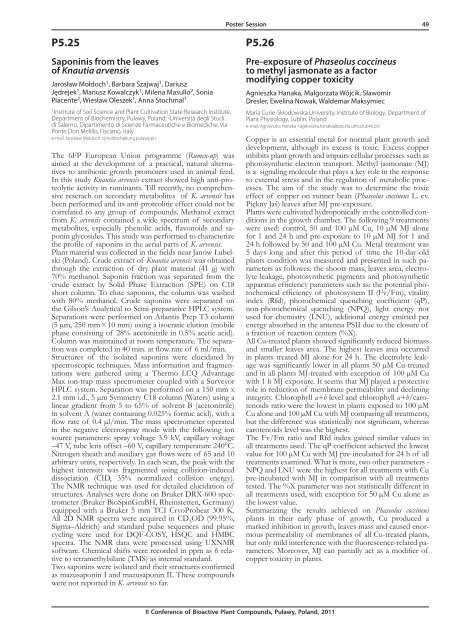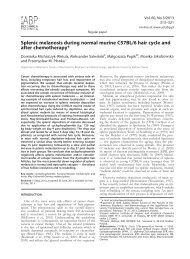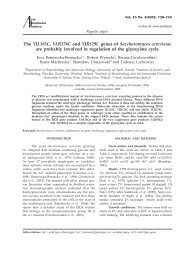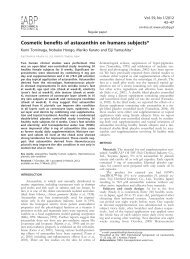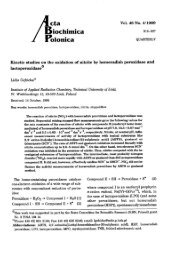Posters P5.1 P5.2 Poster Session - Acta Biochimica Polonica
Posters P5.1 P5.2 Poster Session - Acta Biochimica Polonica
Posters P5.1 P5.2 Poster Session - Acta Biochimica Polonica
You also want an ePaper? Increase the reach of your titles
YUMPU automatically turns print PDFs into web optimized ePapers that Google loves.
<strong>P5.2</strong>5<br />
Saponinis from the leaves<br />
of Knautia arvensis<br />
Jarosław Mołdoch 1 , Barbara Szajwaj 1 , Dariusz<br />
Jędrejek 1 , Mariusz Kowalczyk 1 , Milena Masullo 2 , Sonia<br />
Piacente 2 , Wiesław Oleszek 1 , Anna Stochmal 1<br />
1 Institute of Soil Science and Plant Cultivation State Research Institute,<br />
Department of Biochemistry, Pulawy, Poland; 2 Università degli Studi<br />
di Salerno, Dipartimento di Scienze Farmaceutiche e Biomediche, Via<br />
Ponte Don Melillo, Fisciano, Italy<br />
e-mail: Jaroslaw Moldoch <br />
The 6FP European Union programme (Rumen-up) was<br />
aimed at the development of a practical, natural alternatives<br />
to antibiotic growth promoters used in animal feed.<br />
In this study Knautia arvensis extract showed high anti-proteolytic<br />
activity in ruminants. Till recently, no comprehensive<br />
reserach on secondary metabolites of K. arvensis has<br />
been performed and its anti-proteolitic effect could not be<br />
correlated to any group of compounds. Methanol extract<br />
from K. arvensis contained a wide spectrum of secondary<br />
metabolites, especially phenolic acids, flavonoids and saponin<br />
glycosides. This study was performed to characterize<br />
the profile of saponins in the aerial parts of K. arvensis.<br />
Plant material was collected in the fields near Janów Lubelski<br />
(Poland). Crude extract of Knautia arvensis was obtained<br />
through the extraction of dry plant material (41 g) with<br />
70% methanol. Saponin fraction was separated from the<br />
crude extract by Solid Phase Extraction (SPE) on C18<br />
short column. To elute saponins, the column was washed<br />
with 80% methanol. Crude saponins were separated on<br />
the Gilson’s Analytical to Semi-preparative HPLC system.<br />
Separations were performed on Atlantis Prep T3 column<br />
(5 µm, 250 mm × 10 mm) using a isocratic elution (mobile<br />
phase consisting of 28% acetonitrile in 0.5% acetic acid).<br />
Column was maintained at room temperature. The separation<br />
was completed in 40 min. at flow rate of 6 ml/min.<br />
Structures of the isolated saponins were elucidated by<br />
spectroscopic techniques. Mass information and fragmentations<br />
were gathered using a Thermo LCQ Advantage<br />
Max ion-trap mass spectrometer coupled with a Surveyor<br />
HPLC system. Separation was performed on a 150 mm x<br />
2.1 mm i.d., 5 µm Symmetry C18 column (Waters) using a<br />
linear gradient from 5 to 65% of solvent B (acetonitrile)<br />
in solvent A (water containing 0.025% formic acid), with a<br />
flow rate of 0.4 µl/min. The mass spectrometer operated<br />
in the negative electrospray mode with the following ion<br />
source parameters: spray voltage 3.9 kV, capillary voltage<br />
–47 V, tube lens offset –60 V, capillary temperature 240°C.<br />
Nitrogen sheath and auxiliary gas flows were of 65 and 10<br />
arbitrary units, respectively. In each scan, the peak with the<br />
highest intensity was fragmented using collision-induced<br />
dissociation (CID, 35% normalized collision energy).<br />
The NMR technique was used for detailed elucidation of<br />
structures. Analyses were done on Bruker DRX-600 spectrometer<br />
(Bruker BioSpinGmBH, Rheinstetten, Germany)<br />
equipped with a Bruker 5 mm TCI CryoProbeat 300 K.<br />
All 2D NMR spectra were acquired in CD 3 OD (99.95%,<br />
Sigma–Aldrich) and standard pulse sequences and phase<br />
cycling were used for DQF-COSY, HSQC and HMBC<br />
spectra. The NMR data were processed using UXNMR<br />
software. Chemical shifts were recorded in ppm as δ relative<br />
to tetramethylsilane (TMS) as internal standard.<br />
Two saponins were isolated and their structures confirmed<br />
as mazusaponin I and mazusaponin II. These compounds<br />
were not reported in K. arvensis so far.<br />
<strong>Poster</strong> <strong>Session</strong> 49<br />
<strong>P5.2</strong>6<br />
Pre-exposure of Phaseolus coccineus<br />
to methyl jasmonate as a factor<br />
modifying copper toxicity<br />
Agnieszka Hanaka, Małgorzata Wójcik, Sławomir<br />
Dresler, Ewelina Nowak, Waldemar Maksymiec<br />
Maria Curie-Skłodowska University, Institute of Biology, Department of<br />
Plant Physiology, Lublin, Poland<br />
e-mail: Agniwszka Hanaka <br />
II Conference of Bioactive Plant Compounds, Puławy, Poland, 2011<br />
Copper is an essential metal for normal plant growth and<br />
development, although its excess is toxic. Excess copper<br />
inhibits plant growth and impairs cellular processes such as<br />
photosynthetic electron transport. Methyl jasmonate (MJ)<br />
is a signaling molecule that plays a key role in the response<br />
to external stress and in the regulation of metabolic processes.<br />
The aim of the study was to determine the toxic<br />
effect of copper on runner bean (Phaseolus coccineus L. cv.<br />
Piękny Jaś) leaves after MJ pre-exposure.<br />
Plants were cultivated hydroponically in the controlled conditions<br />
in the growth chamber. The following 9 treatments<br />
were used: control, 50 and 100 µM Cu, 10 µM MJ alone<br />
for 1 and 24 h and pre-exposure to 10 µM MJ for 1 and<br />
24 h followed by 50 and 100 µM Cu. Metal treatment was<br />
5 days long and after this period of time the 10-day-old<br />
plants condition was measured and presented in such parameters<br />
as followes: the shoots mass, leaves area, electrolyte<br />
leakage, photosynthetic pigments and photosynthetic<br />
apparatus efficiency parameters such as: the potential photochemical<br />
efficiency of photosystem II (Fv/Fm), vitality<br />
index (Rfd), photochemical quenching coefficient (qP),<br />
non-photochemical quenching (NPQ), light energy not<br />
used for chemistry (LNU), additional energy emitted per<br />
energy absorbed in the antenna PSII due to the closure of<br />
a fraction of reaction centers (%X).<br />
All Cu-treated plants showed significantly reduced biomass<br />
and smaller leaves area. The highest leaves area occurred<br />
in plants treated MJ alone for 24 h. The electrolyte leakage<br />
was significantly lower in all plants 50 µM Cu-treated<br />
and in all plants MJ-treated with exception of 100 µM Cu<br />
with 1 h MJ exposure. It seems that MJ played a protective<br />
role in reduction of membrane permeability and declining<br />
integrity. Chlorophyll a+b level and chlorophyll a+b/carotenoids<br />
ratio were the lowest in plants exposed to 100 µM<br />
Cu alone and 100 µM Cu with MJ comparing all treatments,<br />
but the difference was statistically not significant, whereas<br />
carotenoids level was the highest.<br />
The Fv/Fm ratio and Rfd index gained similar values in<br />
all treatments used. The qP coefficient achieved the lowest<br />
value for 100 µM Cu with MJ pre-incubated for 24 h of all<br />
treatments examined. What is more, two other parameters -<br />
NPQ and LNU were the highest for all treatments with Cu<br />
pre-incubated with MJ in comparison with all treatments<br />
tested. The %X parameter was not statistically different in<br />
all treatments used, with exception for 50 µM Cu alone as<br />
the lowest value.<br />
Summarizing the results achieved on Phaseolus coccineus<br />
plants in their early phase of growth, Cu produced a<br />
marked inhibition in growth, leaves mass and caused enormous<br />
permeability of membranes of all Cu-treated plants,<br />
but only mild interference with the fluorescence-related parameters.<br />
Moreover, MJ can partially act as a modifier of<br />
copper toxicity in plants.


